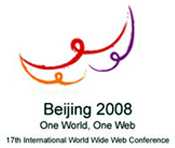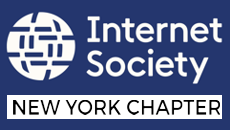Here’s video of last week’s forum:
development
ISOC-NY Public Forum – Connecting .nyc – May 21
 ISOC-NY will host a public forum this coming Wednesday on the topic ‘Connecting.nyc’. Tom Lowenhaupt will give a briefing on the longstanding campaign to bring about a .nyc top-level domain which finally, with Paris and Berlin also on similar paths, looks to be a practical reality.
ISOC-NY will host a public forum this coming Wednesday on the topic ‘Connecting.nyc’. Tom Lowenhaupt will give a briefing on the longstanding campaign to bring about a .nyc top-level domain which finally, with Paris and Berlin also on similar paths, looks to be a practical reality.
This is an important and vital issue for New York City’s global identity. As Tom goes off to make his case at the ICANN meet in Paris next month let’s show him that he has the people’s support!
Date: Wednesday, May 21, 2008
Time: 6.30pm – 8pm
Location: Jefferson Market Library, 425 6th Ave (@9th St) New York NY
Worldwide Lexicon – open source translation
![]() A story in yesterday’s BoingBoing blog details Worldwide Lexicon – a community translation system that enables a website’s readers to translate to the languages they speak. Continue reading
A story in yesterday’s BoingBoing blog details Worldwide Lexicon – a community translation system that enables a website’s readers to translate to the languages they speak. Continue reading
ICANN GNSO gTLD meeting transcript
 ICANN has published a transcript of the morning session of the GNSO New gTLD meetings in Los Angeles on 10-11April. There is also a slideshow of a presentation by ICANN staff member Kurt Pritz, and a flowchart of the proposed application process. mp3 recordings of both morning and afternoon sessions are available. Continue reading
ICANN has published a transcript of the morning session of the GNSO New gTLD meetings in Los Angeles on 10-11April. There is also a slideshow of a presentation by ICANN staff member Kurt Pritz, and a flowchart of the proposed application process. mp3 recordings of both morning and afternoon sessions are available. Continue reading
Tim Berners-Lee press conference at WWW2008 (audio)
 Thanks to Graham Webster of CNET’s Sinobyte, we have audio of Tim Berners-Lee’s press conference at the WWW2008 conference in Beijing last week. Continue reading
Thanks to Graham Webster of CNET’s Sinobyte, we have audio of Tim Berners-Lee’s press conference at the WWW2008 conference in Beijing last week. Continue reading
ICANN accepting comments on PIR’s implementation of DNSSEC for .ORG

![]() The Internet Corporation for Assigned Names and Numbers (ICANN) is opening a comment period on the Public Interest Registry’s (PIR) proposed implementation of DNS Security Extensions (DNSSEC) in .ORG. The Public Interest Registry (PIR) is a not-for-profit corporation created by the Internet Society (ISOC) and is a major source of funding.The Internet Society of New York is a Chapter of ISOC.
The Internet Corporation for Assigned Names and Numbers (ICANN) is opening a comment period on the Public Interest Registry’s (PIR) proposed implementation of DNS Security Extensions (DNSSEC) in .ORG. The Public Interest Registry (PIR) is a not-for-profit corporation created by the Internet Society (ISOC) and is a major source of funding.The Internet Society of New York is a Chapter of ISOC.
DNSSEC digitally signs DNS records but doesn’t encrypt DNS traffic. DNS responses are validated as legitimate and not hacked or tampered with. This ensures users don’t get sent to phishing sites when requesting a legitimate website. DNS security has increasingly become a concern, with DNS being prone to this type of attack, as well as being vulnerable to distributed denial-of-service (DDOS) attacks such as the one that temporarily crippled two of the Internet’s 13 DNS root servers last year. Continue reading
Satellite based Internet for the developing world
Students from the Space Systems Engineering program at the University of Michigan have worked on designing a low-cost system for internet connectivity in developing countries. This presentation focuses on their proposed solution to delivering such capabilities to the rural populations of Africa. In addition, upcoming technologies are discussed that will impact similar missions in the future.
CFP: IETF workshop on P2P Infrastructure – MIT – May 28
 The Real-time Applications & Infrastructure (RAI) Area of the Internet Engineering Task Force (IETF) will hold a workshop on P2P Infrastructure on May 28, 2008 at 50 Vassar St, Room 34-101 on the MIT campus in Cambridge, MA USA. They are calling for papers to be submitted before May 9. Continue reading
The Real-time Applications & Infrastructure (RAI) Area of the Internet Engineering Task Force (IETF) will hold a workshop on P2P Infrastructure on May 28, 2008 at 50 Vassar St, Room 34-101 on the MIT campus in Cambridge, MA USA. They are calling for papers to be submitted before May 9. Continue reading
Senate holds Future of The Internet hearing
 On April 22 2008 the United States Senate Committee on Commerce, Science and Transportation held a full committee hearing on that popular current topic ‘The Future of the Internet’. Amongst those testifying were Kevin Martin of the FCC and Larry Lessig of Stanford.
On April 22 2008 the United States Senate Committee on Commerce, Science and Transportation held a full committee hearing on that popular current topic ‘The Future of the Internet’. Amongst those testifying were Kevin Martin of the FCC and Larry Lessig of Stanford.
A RealVideo webcast is available which isoc-ny has transcoded to mp3 for convenience.
AT&T: Internet to hit full capacity by 2010
 A CNET article reports that, at a recent forum in London Jim Cicconi, VP of legislative affairs for AT&T, warned that the current systems that constitute the Internet will not be able to cope with the increasing amounts of video and user-generated content being uploaded.
A CNET article reports that, at a recent forum in London Jim Cicconi, VP of legislative affairs for AT&T, warned that the current systems that constitute the Internet will not be able to cope with the increasing amounts of video and user-generated content being uploaded.
“The surge in online content is at the center of the most dramatic changes affecting the Internet today,” he said. “In three years’ time, 20 typical households will generate more traffic than the entire Internet today.”
FCC Net Neutrality hearing webcast – Apr 17

 Pulvermedia’s VON TV service will webcast the FCC’s en banc Hearing on Internet Practices at Stanford Law School on Thursday April 17.
Pulvermedia’s VON TV service will webcast the FCC’s en banc Hearing on Internet Practices at Stanford Law School on Thursday April 17.
The sessions run from (EST) 3pm-5.15pm and 6pm-10pm. Continue reading
Jonathan Zittrain – The Future of the Internet – And How to Stop It (video)
Futures of the Internet – April 16 – NYU
 ISOC-NY is proud to be a co-sponsor of a colloquium at NYU this coming Wednesday April 16 – Futures of the Internet.
ISOC-NY is proud to be a co-sponsor of a colloquium at NYU this coming Wednesday April 16 – Futures of the Internet.
What will come of the next decade on the Internet? We often take for granted the state of the net today, but there’s no guarantee that it will remain this way. Will the digital future be dystopian, or is there a brighter outlook ahead than some may believe? Our panelists — thinkers and net visionaries — will provide their perspectives on the future of the net, with backgrounds ranging from art, law, technology, politics, media, culture, and entrepreneurship. We will tap in to each speaker’s knowledge to provide a unique vision of the digital future, and will engage with members of the audience to further the exploration of what lies ahead. Continue reading
USA ranks #4 in W.E.F. Network Readiness Index
 The United States is ranked 7th worldwide in a Networked Readiness Index in a new report issued by the World Economic Forum. The index is based on a variety of economic and political as well as technical factors.
The United States is ranked 7th worldwide in a Networked Readiness Index in a new report issued by the World Economic Forum. The index is based on a variety of economic and political as well as technical factors.
This is in contrast to last year’s OECD report, based on tighter criteria of bandwidth and connectivity, that ranked the United States 19th worldwide.
Microsoft launches ‘End to End Trust’ effort
 In an opening keynote address at the RSA conference in San Francisco today, Craig Mundie, chief research and strategy officer at Microsoft, called for broad discussions about the safety of the Internet in an initiative called “End to End Trust“.
In an opening keynote address at the RSA conference in San Francisco today, Craig Mundie, chief research and strategy officer at Microsoft, called for broad discussions about the safety of the Internet in an initiative called “End to End Trust“.
Core to the concept is something called “a trusted stack,” where security is housed or rooted in the hardware, but each piece — the hardware, software, the data and even the people involved — can be authenticated if necessary.


